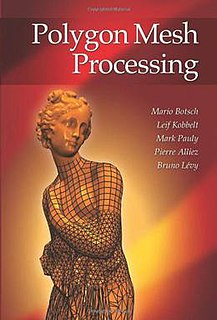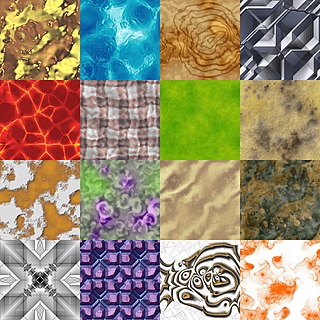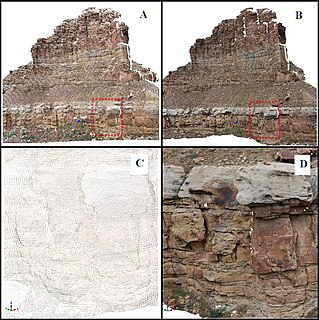Given two surfaces with the same topology, a bijective mapping between them exists. On triangular mesh surfaces, the problem of computing this mapping is called mesh parameterization. The parameter domain is the surface that the mesh is mapped onto.
Parameterization was mainly used for mapping textures to surfaces. Recently, it has become a powerful tool for many applications in mesh processing.[ citation needed ] Various techniques are developed for different types of parameter domains with different parameterization properties.

Texture mapping is a method for defining high frequency detail, surface texture, or color information on a computer-generated graphic or 3D model. The original technique was pioneered by Edwin Catmull in 1974.

In 3D computer graphics, normal mapping, or Dot3 bump mapping, is a texture mapping technique used for faking the lighting of bumps and dents – an implementation of bump mapping. It is used to add details without using more polygons. A common use of this technique is to greatly enhance the appearance and details of a low polygon model by generating a normal map from a high polygon model or height map.

In mathematics, a map is often used as a synonym for a function, but may also refer to some generalizations. Originally, this was an abbreviation of mapping, which often refers to the action of applying a function to the elements of its domain. This terminology is not completely fixed, as these terms are generally not formally defined, and can be considered to be jargon. These terms may have originated as a generalization of the process of making a geographical map, which consists of mapping the Earth surface to a sheet of paper.

Subsurface scattering (SSS), also known as subsurface light transport (SSLT), is a mechanism of light transport in which light that penetrates the surface of a translucent object is scattered by interacting with the material and exits the surface at a different point. The light will generally penetrate the surface and be reflected a number of times at irregular angles inside the material before passing back out of the material at a different angle than it would have had if it had been reflected directly off the surface. Subsurface scattering is important for realistic 3D computer graphics, being necessary for the rendering of materials such as marble, skin, leaves, wax and milk. If subsurface scattering is not implemented, the material may look unnatural, like plastic or metal.

Geometry processing, or mesh processing, is an area of research that uses concepts from applied mathematics, computer science and engineering to design efficient algorithms for the acquisition, reconstruction, analysis, manipulation, simulation and transmission of complex 3D models. As the name implies, many of the concepts, data structures, and algorithms are directly analogous to signal processing and image processing. For example, where image smoothing might convolve an intensity signal with a blur kernel formed using the Laplace operator, geometric smoothing might be achieved by convolving a surface geometry with a blur kernel formed using the Laplace-Beltrami operator.

Mesh generation is the practice of creating a mesh, a subdivision of a continuous geometric space into discrete geometric and topological cells. Often these cells form a simplicial complex. Usually the cells partition the geometric input domain. Mesh cells are used as discrete local approximations of the larger domain. Meshes are created by computer algorithms, often with human guidance through a GUI, depending on the complexity of the domain and the type of mesh desired. The goal is to create a mesh that accurately captures the input domain geometry, with high-quality (well-shaped) cells, and without so many cells as to make subsequent calculations intractable. The mesh should also be fine in areas that are important for the subsequent calculations.
A Least squares conformal map (LSCM) is a 2-D representation of a 3-D shape created using the Least Squares Conformal Mapping Method. By using the map as a guide when creating a new 2-D image, the colors of the 2-D image can be applied to the original 3-D model.

UV mapping is the 3D modeling process of projecting a 2D image to a 3D model's surface for texture mapping. The letters "U" and "V" denote the axes of the 2D texture because "X", "Y", and "Z" are already used to denote the axes of the 3D object in model space, while "W" is used in calculating quaternion rotations, a common operation in computer graphics.
A texture mapping unit (TMU) is a component in modern graphics processing units (GPUs). Historically it was a separate physical processor. A TMU is able to rotate, resize, and distort a bitmap image, to be placed onto an arbitrary plane of a given 3D model as a texture. This process is called texture mapping. In modern graphics cards it is implemented as a discrete stage in a graphics pipeline, whereas when first introduced it was implemented as a separate processor, e.g. as seen on the Voodoo2 graphics card.
Strata Design 3D CX is a commercial 3D modeling, rendering and animation program developed in St. George, Utah by Corastar, Inc. dba Strata Software. Strata is a pioneer and developer of 3D design software.
Thin plate splines (TPS) are a spline-based technique for data interpolation and smoothing. They were introduced to geometric design by Duchon. They are an important special case of a polyharmonic spline. Robust Point Matching (RPM) is a common extension and shortly known as the TPS-RPM algorithm.
ISO 25178: Geometrical Product Specifications (GPS) – Surface texture: areal is an International Organisation for Standardisation collection of international standards relating to the analysis of 3D areal surface texture.

The finite element method (FEM) is a widely used method for numerically solving differential equations arising in engineering and mathematical modeling. Typical problem areas of interest include the traditional fields of structural analysis, heat transfer, fluid flow, mass transport, and electromagnetic potential.

In computer graphics, a procedural texture is a texture created using a mathematical description rather than directly stored data. The advantage of this approach is low storage cost, unlimited texture resolution and easy texture mapping. These kinds of textures are often used to model surface or volumetric representations of natural elements such as wood, marble, granite, metal, stone, and others.
3D-Coat is a commercial digital sculpting program from Pilgway designed to create free-form organic and hard surfaced 3D models from scratch, with tools which enable users to sculpt, add polygonal topology, create UV maps, texture the resulting models with natural painting tools, and render static images or animated "turntable" movies.

A digital outcrop model (DOM), also called a virtual outcrop model, is a digital 3D representation of the outcrop surface, mostly in a form of textured polygon mesh.
In graph drawing and geometric graph theory, a Tutte embedding or barycentric embedding of a simple 3-vertex-connected planar graph is a crossing-free straight-line embedding with the properties that the outer face is a convex polygon and that each interior vertex is at the average of its neighbors' positions. If the outer polygon is fixed, this condition on the interior vertices determines their position uniquely as the solution to a system of linear equations. Solving the equations geometrically produces a planar embedding. Tutte's spring theorem, proven by W. T. Tutte (1963), states that this unique solution is always crossing-free, and more strongly that every face of the resulting planar embedding is convex. It is called the spring theorem because such an embedding can be found as the equilibrium position for a system of springs representing the edges of the graph.
This is a glossary of terms relating to computer graphics.